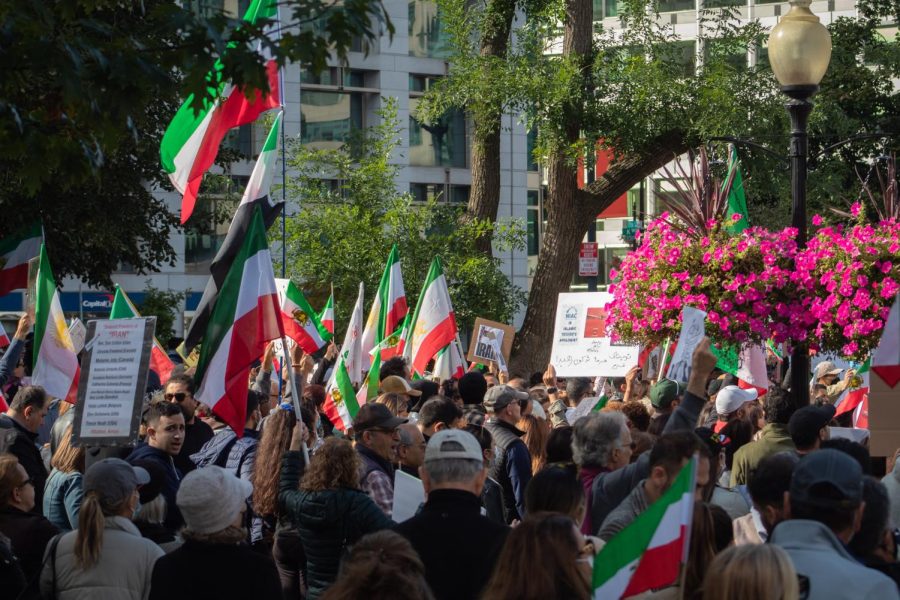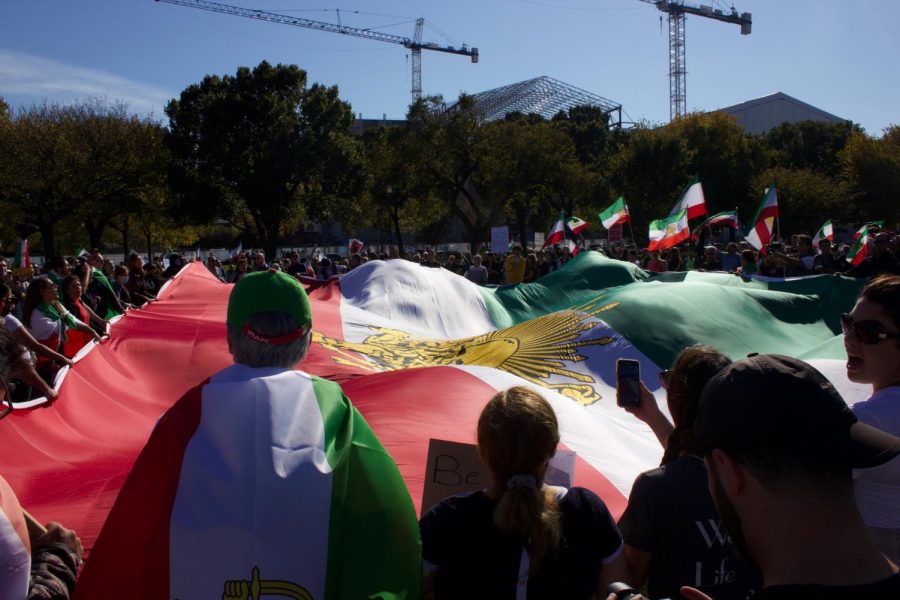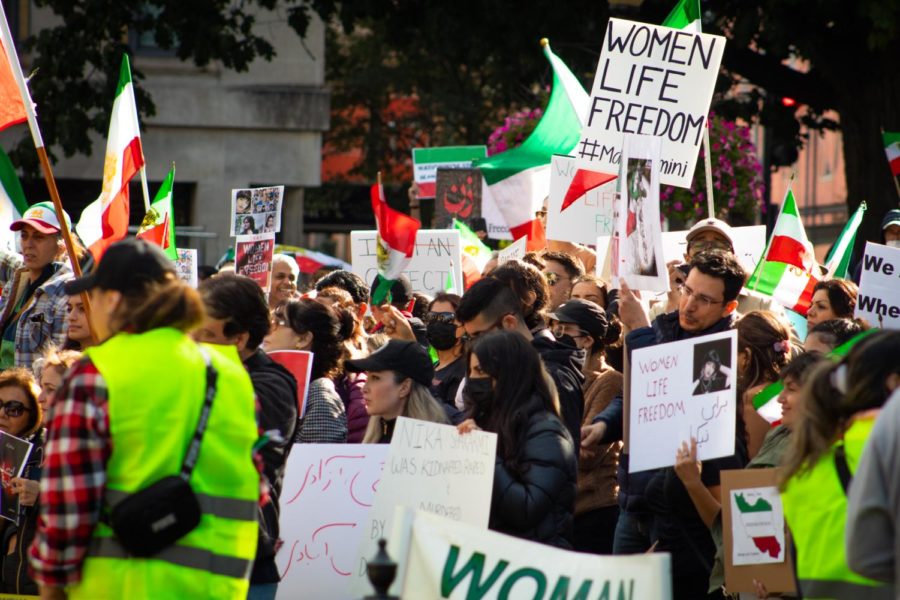Navin Davoodi
The streets of D.C. flood with images of Mahsa Amini, a 22-year-old Iranian woman while calls for women’s rights and freedom of expression resonate through the air.
“Woman, Life, Freedom”: Thousands demand change in Iran at D.C. protests
Each Saturday afternoon since Sept. 23, chants of “Zan Zendigi Azadî” — Farsi for “Woman, Life, Freedom” — have filled the National Mall. Thousands huddle around the green, white and red Iranian flag embroidered with a golden lion, the Persian flag, in protest of the “sexist administration” within the Iranian government. The Syrian opposition flag, the Kurdish flag, LGBTQ+ flags and the Persian flag also wave, representing the freedom that they desire.
Poster boards read “Our hair may offend you but our minds will end you,” “Freedom for Iran” and “The Islamic republic is killing our children.”
The streets of D.C. flood with images of Mahsa Amini, a 22-year-old Iranian woman, while calls for women’s rights and freedom of expression resonate through the air. After Iran’s religious morality police brutally killed Amini on Sept. 16 for not fully covering her hair with her hijab, the 22-year-old’s death became a symbol of her nation’s repressive regime and catalyzed worldwide protests. The demonstrations transformed into a protest movement against the entire Iranian regime because Iranians feel that “enough is enough,” said an Iranian protester named Amin, who told The Black & White that he had been exiled by the Iranian government.
In the weeks following Amini’s death, protests erupted in the provinces of Kurdistan, Tehran, Rasht, Isfahan and even Qom, which is among the most religiously conservative cities in Iran.
The recent wave of demonstrations evoked images past protest movements, but are distinctive in their duration and cohesion. Women have emerged as the face of the movement, which is notable because of the regime’s history of repressing women. Protesters said that they hope this movement will take down the Iranian regime, but after decades of repression and poor economic conditions, a different future for Iran may be hard to achieve.

In both Iran and on the streets of D.C., younger generations of Iranian Americans have been the lead voices in the fight for basic human rights.
Iranian student Melina Momeni, a junior at Walter Johnson High School, said that the men with outdated religious beliefs running Iran don’t understand they are isolating women for their own personal and political gain.
“Freedom of speech is really important,” Momeni said. “Men can do whatever they want while the women have to wear a hijab and are forced to be isolated from society just because of expectations.”
Protesters are demanding representation in a democratic Iran, instead of oppression under the Islamic Republic of Iran, Amin said. When news sources mention Iran, the stories are always upsetting because the current Iranian leaders’ ideologies are outdated, they said.
“Every day when you hear about Iran in the news, what you hear are very sad stories,” Amin said. “When you look at our leaders, they are so stupid and have some very old ideologies.”
Since September, Whitman senior Connor Curran has attended the protests in D.C. on 20 different weekends to show opposition to Iran’s regime and express support for Syrian independence from a similarly corrupt government.
“Iran needs to evolve — government-wise — and change a lot of the rules,” Curran said. “This is hard because the government right now, which is very religious and run by men, is just thinking of what pleases them, but they don’t think about the lives they’re ruining.”
Since the protests began on Sept. 16, Iranian authorities have increasingly resorted to excessive and lethal force to suppress protests within its borders, leaving families concerned for their futures, Momeni said. Protesters — like Momeni — who have families in Iran are careful to avoid showing their faces on all national television broadcasts because doing so could endanger their families in Iran, she said.
While the D.C. protests have remained peaceful and police block off the streets to protect protesters, demonstrators in Iran have faced violent repercussions from the Iranian government for speaking up like physical beatings and threats to exile protesters from the country, Momeni said.
Reports of executed protestors cause many Iranian Americans to worry for their families back in Iran, Amin said. Iran performed the first known execution of a prisoner arrested during protests on Dec. 8.
“The people of Iran are in the streets now, my brother is in the street every night,” he said. “I’m really worried and concerned about my brother. In November 2019, he got shot in the eye with plastic bullets.”
In late 2019, protests took place in Iran due to the increase in fuel prices. Bloody November, the most violent unrest since the Iranian revolution in 1979, resulted in thousands of injuries and more than 300 documented deaths.
The sense of belonging protesters find together is centered around their shared fight for “Freedom for Iran.” Economic problems arise in Iran from the fast-falling national currency, the boycotting of large retailers, a lack of internet access, increased unemployment due to sanctions and the shortage of natural gas in the winter. Curran believes that the Islamic Republic simply uses the U.S., Israel and women as their scapegoats as it is easier for the regime to distract from the country’s economic woes by blaming others. Detaining women for rape, premarital sex and obscenity by not wearing loose clothes or hijab to distract from the fact that the “Islamic economy” is crumbling, Curran added.
On the National Mall, one of the protesters’ demands is that the United States avoid negotiation with, the National Iranian American Council (NIAC), a 501(c)(3) non-profit organization committed to increasing Iranian-American political representation. Some Iranian Americans feel the council doesn’t protect the people of Iran and suspect the NIAC is lobbying with the Iranian regime and they therefore do not trust them, Amin said. The NIAC denies affiliation with the Iranian government.

Whitman junior Kimia Rahnama lived in Iran until sixth grade and said that she experienced firsthand the injustices and limitations the Iranian regime has forced on its people. Rahnama attended an all-girls school in Shiraz, Iran, and was prohibited from being in public without wearing a hijab or the supervision of her parents.
In second grade, her hijab slipped down and the school immediately notified her parents and asked her to leave.
“The impact that living in Iran had on me will remain with me forever,” Rahnama said. “I sometimes catch myself feeling inferior to men. My whole life I have been taught that my dad and the males in my life have an upper hand in decision-making. These protests are not only people demanding equality for women, but it’s also to bring justice to many of the lives that have been lost for simple crimes.”
Since the protests began, her family members living in Iran haven’t been able to leave their houses or attend school. Rahnama and her family haven’t participated in any protests because they fear the Iranian regime will hurt their loved ones in Iran, she said.
The Iranian government manipulates religion to justify its actions, Rahnama added. The regime monitors video calls and other forms of communication with her family in Iran, which forces them to resort to communication in code language. By speaking up against the government on social media, Rahnama’s extended family warned her mother that they fear she could lose her Iranian citizenship if she travels back to Iran, Rahnama said.
On Dec. 4, a top Iranian prosecutor said that Iran abolished the country’s morality police in response to protests; however, the Iranian government did not confirm and officials have since published conflicting statements. While many Iranians have been pushing for the abolition of the morality police, others believe that the problem lies deeper within the Iranian government, Amin said.
The Iranian government continues to punish protesters and has carried out two known executions. Prisoners are awaiting trial while 20 student protesters were banned from taking classes after voicing their opinions of the Iranian government. For Rahnama, the protests in D.C. and in Iran are an important start, but she fears that they could end in a way that is all too familiar.
“I’m very happy that people are having their voices heard and are able to stand up against the government,” Rahnama said. “However, deep down I know people will lose their lives and nothing will change.”
Some names have been changed to protect anonymity.
This story was originally published on The Black & White on January 12, 2023.

